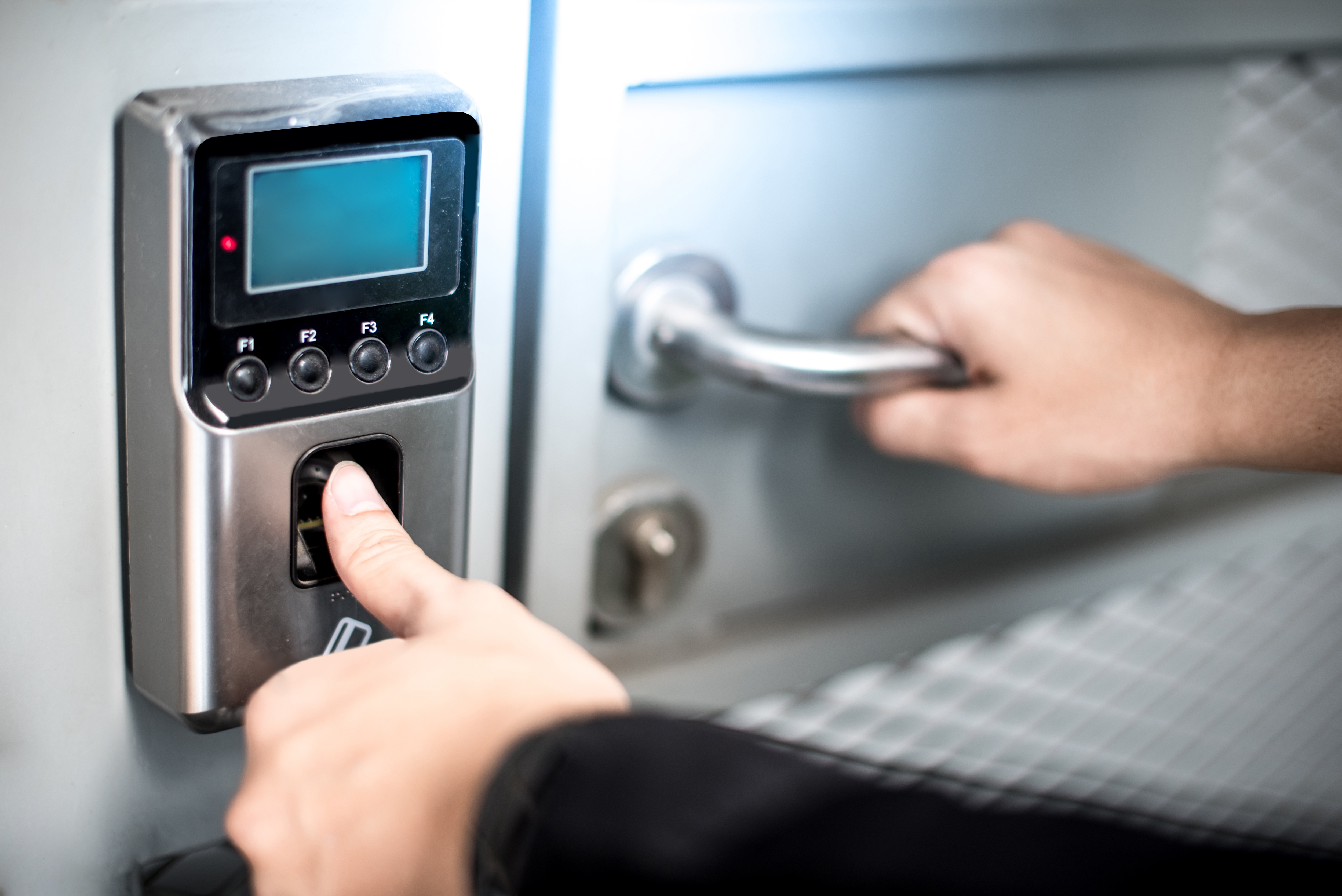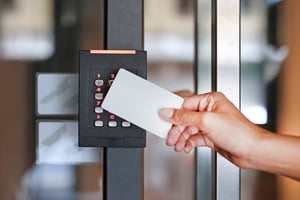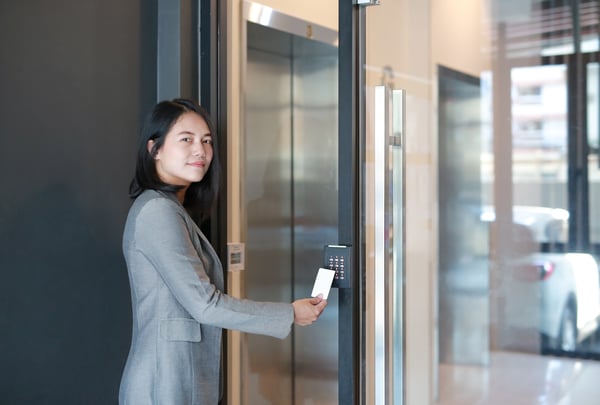Fundamentals of Access Control for Business
Access control is a fundamental part of business security. It’s a standard security process that determines who’s allowed to do what in a company – as well as validating visitors and keeping tabs on who’s moving through the facility.
It’s a security practice as old as the lock and key. But modern access control for businesses goes well beyond basic door locks and security cameras. The typical business security system may include exterior access control readers, intrusion monitoring sensors, coordination with external alarm systems, and connections with closed-circuit television (CCTV) surveillance systems.
Yes, modern security solutions have come a long way over the past few years, and business owners have more options at their disposal than ever before. Typically, these options are split into several categories, depending on how they help the company meet its security goals:
- Discretionary: Access is controlled by a single administrator who grants privileges as needed.
- Mandatory: Access is restricted for all users, backed by security protocols that limit building access for those without security clearance.
- Role-based: A hybrid system that allows administrators to grant access to specific company roles or classifications in the employee hierarchy.
- Rule-based: Access is granted based on certain criteria that must be met; for example, allowing access only on certain days of the week.
The great thing about these systems is that they’re flexible. There’s no one size fits all solution; each access control system can be tailored to the business in question.
Read More:

Access Control Features and Integrations
The above definitions describe how access control systems can be set up to manage visitor access, but there’s plenty more that these systems can do.. Sure, basic entry systems like mag-stripe readers, keypad readers, or biometric readers help keep the doors locked – but in terms of a fully integrated business security solution, these are only the tip of the iceberg.
Modern access control systems can integrate with a company’s other security and surveillance equipment to bring new dimensions to business security. For example, access control points can have video intercoms installed to provide a visual element to visitor screening. They can also be connected directly to a company’s existing CCTV monitoring systems.
And even beyond business security, these integrations can help curtail unwanted business behaviors from customers. For example, when gym patrons “tailgate” on one another’s entry credentials. The right access control system can account for this and prevent this type of theft before it begins.
It might sound like a big project, but with the right tools, it’s easy to coordinate these systems. Users can set up remote access to their camera systems to give administrators easy ways to monitor and review data, and when integrated in a fully wireless system, it can be managed from anywhere.
Read More:
Applications of Access Control
Naturally, every business needs some type of access control to protect its premises, though some facilities may particularly benefit from additional security investments.
Commercial offices
Whether it’s for a single location or multi-site facilities, commercial offices need reliable ways to protect business assets. This may mean setting up credentials to allow visitors access to the building, or establishing in-office controls for who can access what.
Hospitals
Hospital security is crucial for keeping healthcare staff and vulnerable patients safe. As such, most hospitals set up access control systems throughout their facilities, often leveraging role-based or mandatory systems that limit where visitors can go without supervision.
Universities
University buildings see substantial amounts of foot traffic on a daily basis, and as such, security is paramount. Administrators can set up access control for specific buildings, including residence halls, classrooms, laboratories, or clerical offices. With so many people coming and going, this type of user validation is a must.
Read More:
Should I Choose Wireless or Wired Access Control?
 One of the biggest decisions that business owners will make is choosing between wired and wireless access control systems. While each offers distinct advantages, businesses will need to choose the option that makes the most sense for their security goals and available infrastructure.
One of the biggest decisions that business owners will make is choosing between wired and wireless access control systems. While each offers distinct advantages, businesses will need to choose the option that makes the most sense for their security goals and available infrastructure.
Wired Access Control
The more traditional of the two options, wired access control systems use hardware that physically connects control equipment with a central control hub. These hardwired systems tend to be highly reliable and quite secure, relatively speaking. They also have the advantage of being connected directly to the building’s power source, meaning no batteries to worry about.
The biggest drawback of wired access systems is the cost of installation. Setting up the physical infrastructure can be costly, particularly for older buildings, meaning that a system like this may not be viable for smaller companies.
Wireless Access Control
On the other side of the coin, we have wireless access control systems. As the name suggests, these solutions use Wi-Fi and radio signals to allow system access from anywhere – either online or offline. Naturally, these systems are easy to set up and easy to deploy, as connections are made remotely. Just set up the hardware and you’ll be good to go. They’re generally much cheaper than wired solutions.
The downside of wireless systems is that they’re less reliable, and arguably less secure than hardline systems. Companies will need to account for the range of their devices, what to do in the event of downtime, and robust password/authentication management to protect the system itself.
Again, one option isn’t inherently better than the other. It all comes down to what a business needs to accomplish with its available resources.
Read More:
Cloud-based vs. On-Site Access Control
Another key distinction in access control systems is whether the solution is hosted on-premise or off-site. Like the wireless vs. wired debate, each of these options may be more suitable for certain businesses. Let’s compare the two.
On-Site
Every access control system is powered by data, and traditional on-site access control systems require the installation of servers and software to manage all of it. This approach lets businesses retain complete control of their data (and avoid relying on continuous internet connectivity), while also offering a higher grade of security. The drawback is that up front installation costs tend to be higher, and they’re much more difficult to scale, should the company grow.
Cloud-Based
Cloud-based access control involves working with a service provider who can host the security solution and manage data off-site. Users can access their systems through online and mobile portals, giving them the benefits of business security without the ongoing hassles inherent to on-site server management.
Typically, cloud-based access control systems offer great levels of flexibility and scalability, even coming with lower up front costs than traditional systems. The main drawbacks here are giving up control of your data (to some degree, at least), and having your security system be reliant on a stable internet connection. Should the system go down, the security infrastructure won’t function as it should.
Read More:
Access Control Integration Costs
.jpeg?width=600&name=AdobeStock_224544073%20(1).jpeg)
Although the exact costs of your access control system will depend on its features, your total level of investment will depend on three variables:
- The initial hardware investment, including PIN pads or card readers
- Installation costs of your chosen system
- The ongoing maintenance costs of keeping your system running
It’s important to keep these costs in mind as you plan out your system. A top-of-the-line security system might be ideal, but the ongoing expenses of equipment maintenance need to be balanced against its up front costs. For example, wired access control systems tend to be more expensive up front, as they require physical installation of infrastructure throughout the facility. However, there’s no ongoing subscription fees to worry about. Contrast this with a wireless system, which comes with a subscription fee, but with much lower installation costs.
And that’s just the basic system to consider; there’s also different options for integration features (as detailed above) that will influence the total cost of the system. Companies need to take a thorough approach to security planning here, accounting for initial costs, management costs, and possible upgrades down the line.
Read More:


